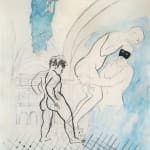Francis Picabia
Further images
Francis Picabia’s drawing, executed in Indian ink and watercolor, belongs to his Transparencies series, a pivotal body of work developed between 1927 and the early 1930s. This period marked a radical departure from his earlier satirical and Dadaist provocations, steering him toward a cryptic synthesis of classical, mythological, and contemporary imagery. The Transparencies are distinguished by their superimposed compositions, where figures and architectural elements dissolve into one another, generating a sense of temporal simultaneity and spectral presence. This technique, indebted to Renaissance painting, esoteric symbolism, and Picabia’s ongoing engagement with spatial ambiguity, evokes the complex layering of Futurism and Cubism, yet it defies the formalist precision of those movements in favor of an elusive, dreamlike poetics. The drawing presented here exemplifies this aesthetic, interweaving sensuality, mysticism, and theatricality, challenging conventional boundaries between past and present, figuration and abstraction.
The iconography of this work underscores Picabia’s fascination with the interplay between classical antiquity and modern eroticism, a dynamic tension that characterizes the Transparencies as a whole. The masked figure, a recurrent motif in this series, introduces a sense of concealment and performativity, possibly invoking the commedia dell’arte tradition or the subversive allure of masked identities in fin-de-siècle visual culture. The intertwined nude figures, delineated with delicate yet assertive contours, exude a fragile intimacy while maintaining an ethereal detachment, their forms floating rather than fully anchored within the pictorial space. Above them, a lyre-playing figure, rendered in translucent blue, suggests a direct reference to Apollo or Orpheus, reinforcing Picabia’s engagement with mythological themes and their enduring aesthetic resonance. Meanwhile, the gridded foreground, punctuated by nodal points, subtly evokes scientific or mathematical frameworks, recalling Leonardo da Vinci’s perspective studies or the esoteric geometries that fascinated modernist thinkers attempting to reconcile intuition with structure, mysticism with logic.
Stylistically, Picabia’s use of Indian ink and watercolor enhances the Transparencies’ ghostly, palimpsestic quality. The fluidity of his ink lines, at times sharp and deliberate, at others dissipating into vaporous uncertainty, creates a dynamic sense of perpetual movement and dissolution. His judicious application of blue watercolor washes heightens the illusion of depth, segmenting the composition into luminous, veiled layers, while simultaneously echoing the ethereal hues of early photographic cyanotypes. Unlike the aggressive iconoclasm of his Dada years, the Transparencies suggest a meditative, almost incantatory introspection, aligning them with Surrealist explorations of unconscious imagery, though Picabia remained defiantly independent from Breton’s circle. His rejection of formalist purity in favor of eclecticism, contradiction, and historical pastiche positions him as a precursor to postmodern strategies of appropriation and deconstruction, anticipating the visual methodologies of Sigmar Polke and David Salle, who would later adopt similarly layered and destabilized pictorial languages.
Within the larger trajectory of 20th-century modernism, this drawing encapsulates Picabia’s radical refusal to be confined by a single movement or doctrine. If it stands as a repudiation of his Dadaist irreverence, it also prefigures his later, more figurative and frequently subversive paintings of the 1940s, where photorealism collides with kitsch and the banal intrudes upon the exalted. The Transparencies, therefore, hold a singular position in modern art: they do not merely synthesize avant-garde innovation with art-historical reverence, but rather, they destabilize both, exposing the malleability of visual tradition. By the late 1920s, as Surrealism and geometric abstraction sought to establish competing orthodoxies within modernist discourse, Picabia’s Transparencies emerged as an alternative paradigm—one that embraced ambiguity, fragmentation, and an idiosyncratic, deeply personal iconography, offering a vision of modernity that was at once nostalgic and radically destabilizing.
NOTES
This artwork is signed in ink in the lower right margin.
Provenance
Simone Collinet, Paris
Galerie Fürstenberg, Paris
Private collection, Europe
Galerie Natalie Seroussi, Paris
Private collection
Acquired from the above by the present owner
Exhibitions
Galerie Joycelyn Wolff, Romainville, France, Transformer le monde, changer la vie: une bibliothèque surréaliste, March 11 - December 21, 2024.
Literature
Maurizio Fagiolo Dell'Arco. Francis Picabia. Milan, 1976. p. 22, n° 117 (illustrated).
Maria-Lluïsa Borràs, Picabia. Paris: Albin Michel, 1985, p. 520, no. 585 (illustrated).
Aurélie Verdier, ‘[SIC] Picabia: Ego, Reaction, Reuse,’ October, n° 157, MIT, Cambridge, Massachusetts, Summer 2016, pp. 63-89 (illustrated in black and white on p. 71).








